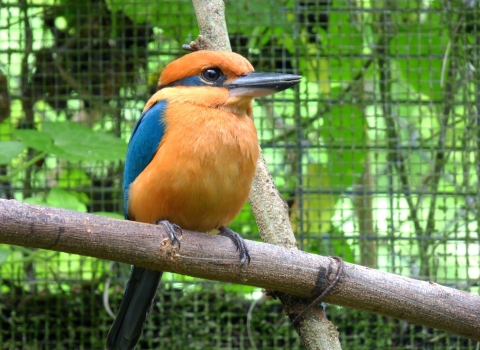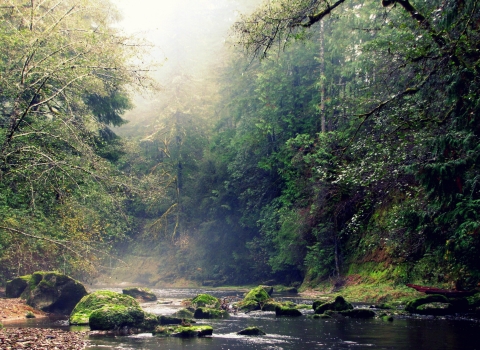HONOLULU — The U.S. Fish and Wildlife Service is proposing the experimental population of sihek (Guam kingfisher, Todiramphus cinnamominus) at The Nature Conservancy's Cooper Island nature preserve and the Palmyra Atoll National Wildlife Refuge. Sihek are endemic to the island of Guam but have been extinct in the wild since 1988 due to predation by the brown tree snake. Currently the species is managed under human care at Association of Zoos and Aquariums facilities in the U.S. mainland and at Guam Department of Agriculture Division of Aquatic and Wildlife Resources. Captive bred sihek would be released on Palmyra Atoll as an experimental population under section 10(j) of the Endangered Species Act, which designates the population as experimental to support the reintroduction of the at-risk species to foster long-term recovery. This has been an on-going collaborative effort with several partner agencies.
“The introduction of sihek to Palmyra Atoll will help us learn about the species response to being back in the wild after 30 years,” said Megan Laut, U.S. Fish and Wildlife Service Recovery Program Manager. “We will also learn the most effective release and monitoring techniques so that we can one day reintroduce the species back on Guam once the invasive brown treesnake can be controlled. It also seeks to increase the global population of this species, as facilities under human care are at capacity.”
The sihek population, like many other native species, declined following the introduction of the predatory brown tree snake to Guam in the 1950s. Today, only two of Guam’s 12 native forest birds remain in the wild. The successful release of the sihek could inspire similar recovery initiatives on Guam, while increasing the species’ global population.
“The disappearance of Guam’s birds has not only impacted our environment, but by losing the sihek and other birds, we have lost members of our community,” said Anthony Tornito, wildlife biologist for Guam Department of Agriculture Division of Aquatic and Wildlife Resources. “This proposed experimental conservation translocation of our sihek to Palmyra Atoll not only benefits the sihek but gives us the opportunity to highlight Guam’s biological uniqueness not just to the community but to the world. This release is coinciding with Guam’s CHamoru cultural renaissance and this initial release on Palmyra Atoll is a catalyst for the species’ eventual, and long-awaited, return to the wild on Guam.”
“Like all extinct-in-the-wild species, the fate of sihek rests directly in our hands,” said Dr. John Ewen of the Zoological Society of London and chair of the Sihek Recovery Team. “We have the opportunity to return this species to the wild in a highly responsible way, learning about their needs in a wild environment with low risk. Preventing extinction requires a substantial increase in sihek numbers and this can best be achieved through wild releases. Palmyra Atoll has the potential to increase the global sihek population by 42%. At the same time, Palmyra Atoll allows close observation of how sihek will cope with the transition to wild living, where we can intervene and support individual birds as needed and also remove them if required. It is rare to have this much control and we will utilize this to secure the recovery of this iconic species.”
The recovery of the sihek has been an ongoing partnership between the Fish and Wildlife Service, Guam Department of Agriculture Division of Aquatic and Wildlife Resources, The Nature Conservancy, Association of Zoos and Aquariums, Wilder Institute/Calgary Zoo, Sedgwick County Zoo, and ZSL (Zoological Society of London).
“At only 5% of Earth’s total land area, islands host a disproportionately large percentage of the planet’s biodiversity,” said Dr. Alex Wegmann, lead scientist for The Nature Conservancy’s Island Resilience Strategy. “Yet, island species are also at greater risk of extinction than species in continental areas. The plan to ‘rewild’ sihek at Palmyra Atoll is a courageous reversal of the island species extinction trend. Through this action, we will not only learn about the sihek diet and habitat needs in a wild setting, we will further thinking towards and practice the safeguarding of Earth’s biodiversity.”
The sihek is a striking cinnamon-brown bird with bright blue wings and tail. It has a long, heavy bill that indicates its predatory feeding behavior. Sihek feeds entirely on animal prey including skinks, geckos, spiders, beetles, and land crabs. They are a “sit and wait predator” that perch motionless on exposed branches and swoop down to capture prey off the ground with their bill. They are socially monogamous, and pairs share responsibilities such as territory defense, incubation, and chick rearing.
This proposed rule will be available for public comment for 30 days. An electronic copy of the document is available at the Federal Register: Click Here
To request additional information or submit written comments, please use one of the following methods.
- You may submit written comments through our website: https://www.regulations.gov
- Follow the instructions for submitting comments on Docket No. FWS-R1-ES-2022-0061.
- You may submit written comments and materials through the mail:
- Public Comments Processing; Attn: Docket No. FWS-R1-ES-2022-0061; U.S. Fish and Wildlife Service, 300 Ala Moana Boulevard, Room 3-122, Honolulu, HI 96850.
For further information contact: Megan Laut, Pacific Islands Fish and Wildlife Office, by email at Megan_Laut@fws.gov. You can also visit our Pacific Islands Fish and Wildlife Office webpage for more information.
In order to be considered, comments must be received on or before September 30. All comments and materials received will become part of the public record associated with this action. The USFWS will accept comments received or postmarked on or before September 30.
###
The Sihek Recovery Program
The Sihek Recovery Program is a global collaborative of conservationists dedicated to recovering one of Guam’s most iconic native species, the sihek (Guam kingfisher, Todiramphus cinnamominus). Extinct in the wild since 1988 due to the accidental introduction of the invasive brown tree snake, sihek now survive only under human care in a facility run by Guam Department of Agriculture’s Division of Aquatic and Wildlife Resources and at Association of Zoos and Aquariums (AZA) institutions on the US mainland. Until threats on Guam are mitigated, the Sihek Recovery Program is working to identify suitable release locations elsewhere to help grow the global sihek population, safeguard the species against extinction, and refine release methods to support the ultimate goal of returning sihek home to Guam. The Sihek Recovery Program is made up of representatives from the following organizations:
USFWS
The U.S. Fish and Wildlife Service works with others to conserve, protect, and enhance fish, wildlife, plants, and their habitats for the continuing benefit of the American people. For more information, visit www.fws.gov/pacificislands, or connect with us through any of these social media channels at https://www.facebook.com/PacificIslandsFWS, www.flickr.com/photos/usfwspacific/, www.tumblr.com/blog/usfwspacific or www.twitter.com/USFWSPacific.
Guam DAWR doag.guam.gov/dawr/
The Guam Department of Agriculture’s Division of Aquatic and Wildlife Resources is dedicated to the conservation, protection and management of Guam’s natural and cultural resources for current and future generations.
ZSL (Zoological Society of London)
Founded in 1826, ZSL (Zoological Society of London) is an international scientific, conservation and educational charity whose mission is to promote and achieve the worldwide conservation of animals and their habitats. The mission is realized through ground-breaking science, active conservation projects in more than 50 countries and two Zoos, ZSL London Zoo and ZSL Whipsnade Zoo.
Sedgwick County Zoo
The Sedgwick County Zoo in Wichita, Kansas, is dedicated to inspiring respect and conservation for wildlife and wild places. Home to nearly 3,000 animals of more than 400 different species, SCZ has been recognized with national and international awards for its support of field conservation programs and successful breeding of rare and endangered species. Opened in 1971, it has been ranked among the best zoos in the United States. The Sedgwick County Zoo is a not-for-profit organization, accredited by the Association of Zoos and Aquariums – a global leader in wildlife conservation.
The Nature Conservancy
The Nature Conservancy is a global non-profit organization dedicated to conserving the lands and waters on which all life depends. Informed by science and guided by traditional values and practices, TNC applies innovative, nature-based solutions to the world’s toughest challenges so that nature and people can thrive. TNC has forged partnerships to manage 14 preserves and other sites in Hawai‘i and Palmyra Atoll, working with government, private parties and communities to protect Hawaii’s and Palmyra’s forests and coral reefs for their ecological value and for the many benefits they provide to people.
Wilder Institute/Calgary Zoo
For more than 30 years, the Calgary Zoo has led critical wildlife conservation work through the Calgary Zoo, its Archibald Biodiversity Centre, as well as across Canada and around the world. The zoo is internationally recognized for world-class animal care and habitat design practices and takes pride in inspiring and educating generations of visitors about the importance of biodiversity and conservation during visits. The Wilder Institute is a wildlife conservation charity that oversees the Calgary Zoo’s conservation portfolio, locally and globally. Together, the Wilder Institute and the Calgary Zoo will continue to be a force of nature for making the world a wilder place.



